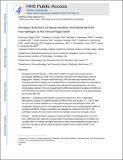| dc.contributor.author | Chang, Che-Feng | |
| dc.contributor.author | Goods, Brittany A | |
| dc.contributor.author | Askenase, Michael H | |
| dc.contributor.author | Beatty, Hannah E | |
| dc.contributor.author | Osherov, Artem | |
| dc.contributor.author | DeLong, Jonathan H | |
| dc.contributor.author | Hammond, Matthew D | |
| dc.contributor.author | Massey, Jordan | |
| dc.contributor.author | Landreneau, Margaret | |
| dc.contributor.author | Love, J Christopher | |
| dc.contributor.author | Sansing, Lauren H | |
| dc.date.accessioned | 2022-05-16T14:37:16Z | |
| dc.date.available | 2022-05-16T14:37:16Z | |
| dc.date.issued | 2021 | |
| dc.identifier.uri | https://hdl.handle.net/1721.1/142536 | |
| dc.description.abstract | Background and Purpose:
Brain tissue-resident microglia and monocyte-derived macrophages (MDMs) are innate immune cells that contribute to the inflammatory response, phagocytosis of debris, and tissue repair after injury. We have previously reported that both microglia and MDMs transition from proinflammatory to reparative phenotypes over days after an intracerebral hemorrhage (ICH). However, their individual functional properties in the brain remain largely unknown. Here we characterized the differences between microglia and MDMs and further elucidate their distinct activation states and functional contributions to the pathophysiology and recovery after ICH.</jats:p>
</jats:sec>
<jats:sec>
<jats:title>Methods:</jats:title>
<jats:p>Autologous blood injection was used to model ICH in mice. Longitudinal transcriptomic analyses on isolated microglia and MDMs from mice at days 1, 3, 7 and 10 after ICH and naive controls identified core transcriptional programs that distinguish these cells. Imaging flow cytometry and in vivo phagocytosis assays were used to study phagocytic ability of microglia and MDMs. Antigen presentation was evaluated by ovalbumin-OTII CD4 T-cell proliferation assays with bone marrow–derived macrophages and primary microglia cultures.
<jats:title>Results:</jats:title>
<jats:p>MDMs had higher phagocytic activity and higher erythrophagocytosis in the ICH brain. Differential gene expression revealed distinct transcriptional signatures in the MDMs and microglia after ICH. MDMs had higher expression of MHCII (major histocompatibility complex class II) genes than microglia at all time points and greater ability to induce antigen-specific T-cell proliferation.</jats:p>
</jats:sec>
<jats:sec>
<jats:title>Conclusions:</jats:title>
<jats:p>The different ontogeny of microglia and MDMs lead to divergent responses and functions in the inflamed brain as these 2 cell populations differ in phagocytic functions and antigen-presenting capabilities in the brain after ICH.</jats:p>
</jats:sec> | en_US |
| dc.language.iso | en | |
| dc.publisher | Ovid Technologies (Wolters Kluwer Health) | en_US |
| dc.relation.isversionof | 10.1161/STROKEAHA.120.032196 | en_US |
| dc.rights | Attribution-NonCommercial-ShareAlike 4.0 International | en_US |
| dc.rights.uri | https://creativecommons.org/licenses/by-nc-sa/4.0/ | en_US |
| dc.source | PMC | en_US |
| dc.title | Divergent Functions of Tissue-Resident and Blood-Derived Macrophages in the Hemorrhagic Brain | en_US |
| dc.type | Article | en_US |
| dc.identifier.citation | Chang, Che-Feng, Goods, Brittany A, Askenase, Michael H, Beatty, Hannah E, Osherov, Artem et al. 2021. "Divergent Functions of Tissue-Resident and Blood-Derived Macrophages in the Hemorrhagic Brain." Stroke, 52 (5). | |
| dc.contributor.department | Massachusetts Institute of Technology. Department of Biological Engineering | |
| dc.contributor.department | Koch Institute for Integrative Cancer Research at MIT | |
| dc.relation.journal | Stroke | en_US |
| dc.eprint.version | Author's final manuscript | en_US |
| dc.type.uri | http://purl.org/eprint/type/JournalArticle | en_US |
| eprint.status | http://purl.org/eprint/status/PeerReviewed | en_US |
| dc.date.updated | 2022-05-16T14:10:18Z | |
| dspace.orderedauthors | Chang, C-F; Goods, BA; Askenase, MH; Beatty, HE; Osherov, A; DeLong, JH; Hammond, MD; Massey, J; Landreneau, M; Love, JC; Sansing, LH | en_US |
| dspace.date.submission | 2022-05-16T14:10:21Z | |
| mit.journal.volume | 52 | en_US |
| mit.journal.issue | 5 | en_US |
| mit.license | OPEN_ACCESS_POLICY | |
| mit.metadata.status | Authority Work and Publication Information Needed | en_US |
